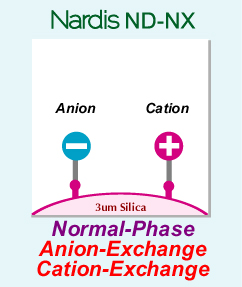
Normal-phase + dual Ion exchange
When conventional columns struggle with retention and separation,

MAIN SPECIFICATIONS
| Particle size: | 3μm |
| Pore size: | 13nm |
| Stationary phase: | Weak anion group + Weak cation group |
| Separation mode: | Normal-phase + Both ion-exchange |
| Target molecular weight: | Below 10kDa |
| pH range of use: | 1.5 - 8 |
| Column pressure resistance: | 3600psi / 250bar / 25MPa (1-6mm ID) |
CAUTION
The dual ion-exchange column is not designed for simultaneous analysis of cationic and anionic substances. The stationary phase contains ion ligands, so it is essential to use a pH modifier and appropriate ion strength in the mobile phase.
As it operates in ion-exchange mode, "gradient elution" is necessary when using this column.
Since the stationary phase consists of weak ion-exchange ligands, substances with multiple ionic functional groups or weakly ionizable substances with a pKa of 4-5 may result in multiple peaks under certain analysis conditions.
Please note that this product does not guarantee retention or peak shape for all substances. Optimization of the analysis requires careful adjustment of the mobile phase (organic solvent, pH, ion strength).
Dual Ion-Exchange Capability
Nardis ND-NX (normal-phase) is equipped with weak anion and weak cation groups. This improves the retention and separation of strongly ionic compounds.
Characteristics of Normal-phase + Dual Ion-Exchange Mode Nardis ND-NX
Nardis ND-NX is a "normal-phase + dual ion-exchange" column that incorporates weak anion and weak cation groups.
In normal-phase mode, solutes are retained when the polarity of the mobile phase is low and eluted when the polarity is increased.
Acidic compounds are strongly retained at acidic pH and eluted as the pH and ion strength are increased.
Basic compounds are strongly retained at neutral pH and eluted as the pH is lowered and ion strength is increased.
Separation Improvement of Amino Column (Unison UK-Amino)
This column enhances the retention and separation of nucleic acid-related compounds that are highly polar and not strongly ionizable.
- Sugar Alcohols (Tetrose Alcohol, Pentose Alcohol)
NEW
Reduction of Acetonitrile under Ammonium Acetate Conditions
- Nucleosides
Decrease in acetonitrile under ammonium formate
- Nucleoside anticancer drugs (Gemcitabine)
Decrease in acetonitrile under ammonium formate
- Xanthine oxidase-related compounds
Decrease in acetonitrile under acetic acid
- Antiviral drugs
Decrease in acetic acid under acetonitrile
- Uridine isomers
Decrease in acetonitrile under acetic acid
- Adenosine metabolism compounds
Decrease in acetonitrile, gradient from formic acid to ammonium formate
- Tenofovir (antiviral drug)
Gradient from formic acid to ammonium formate with decreasing acetonitrile
This column also improves the retention and separation of basic substances.
- Local anesthetics (Lidocaine, Adrenaline)
Decrease in acetonitrile, gradient from ammonium formate to formic acid
This column has the potential to improve monosaccharide retention.
- Xylitol, Xylose, Xylose
Decrease in acetonitrile, increase in ammonium acetate
This column has the potential for simultaneous analysis of uronic acids and amino sugars.
- Glucose, Glucuronic acid, Glucosamine
Decrease in acetonitrile, gradient from ammonium acetate to acetic acid
This column enables group separation of pentoses, hexoses, uronic acids, and amino sugars.
- Group separation of monosaccharides
Decrease in acetonitrile, gradient from ammonium acetate to acetic acid
Alternative to Silica Column (Unison UK-Silica)
This column can serve as an alternative to traditional silica for aqueous normal-phase mode.
- Benfotiamine (Vitamin B1 derivative)
Decrease in acetic acid under acetonitrile
- Anticancer drugs (Gemcitabine)
Decrease in acetic acid under acetonitrile
Application to Phosphate Compounds (Metal-Free Column)
Using the metal-free version of this column, applying normal-phase + ion-exchange mode allows for easy retention and separation of phosphate compounds such as nucleotides and coenzymes.
Applications of Nardis ND-NX
- Uracil related compoundsNEW
- DL-glyceraldehyde,dimerNEW
- Aminoglycoside antibiotics
- Adrenergic amines (comparison of elution with ND-RX)
- Citicoline (psychostimulant)
- Pyrophophoric acid, phosphoric acid
- Nucleobases
- Vitamin B6 (Pyridoxal Pyridoxine Pyridoxamine)
- Biogenic polyamines (MS)
- Synthetic polyamines (MS)
- K value (fish freshness index) related compounds (MS)
- K value (fish freshness index) related compounds (UV)
- Nucleoside metabolism antagonists